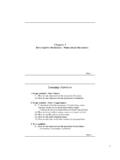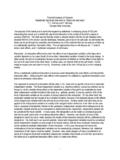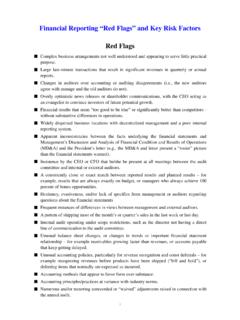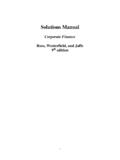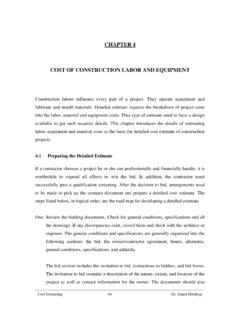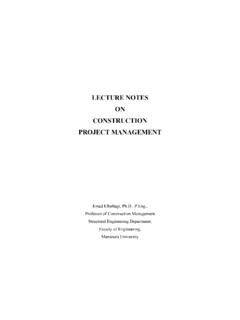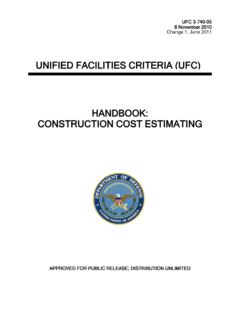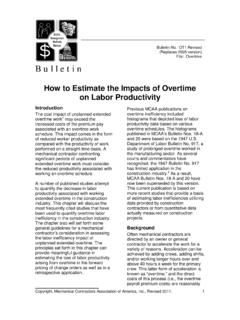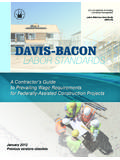Transcription of Chapter 2 Accounting Review: Income Statements …
1 Chapter 2 AAccccoouunnttiinngg RReevviieeww:: IInnccoommee SSttaatteemmeennttss aanndd BBaallaannccee SShheeeettss Chapter Overview The Income Statement The Balance Sheet The Importance of Accounting for Business Operations After studying Chapter 2, you should be able to: Construct a basic Income statement. Identify and define each item on a basic Income statement. Construct a basic balance sheet. Identify and define each item on a basic balance sheet. Describe the difference between Accounting data and cash. Explain the importance of Accounting to a business. Identify the major ways in which a firm may legally manipulate its financial data. Chapter Overview At most schools, Accounting is a prerequisite for the introductory finance course. Thus, you have probably recently taken an Accounting course (or perhaps even two) and you may be tempted to skip this Chapter .
2 DON T!!! As finance professors, it has been our experience that students exiting basic Accounting courses (though often well versed in Accounting ) do not have an adequate understanding of the structure and construction of, and basic relationships between, company Income Statements and balance sheets. Without this understanding, it is impossible to master financial statement analysis - which comprises the next three chapters of this book. Thus, even if you think your Accounting background is strong, we still suggest that you read this Chapter . And, if you find yourself struggling excessively through the remaining chapters of this section of the book, we recommend that you re-read this Chapter - several times if necessary! In this Chapter , we outline the structure and composition of the two main financial Statements used by businesses: the Income statement and the balance sheet. Specifically, we present a basic description of the most common account items found on financial Statements .
3 Keep in mind that the descriptions presented in this Chapter are from the point of view of a financial manager as opposed to an accountant. A financial manager is not particularly interested in how accounts are kept or recorded ( , T-accounts). A financial manager must, however, intuitively understand the nature of financial statement accounts before effective financial analysis and management can be achieved. The Income Statement The Income statement, also called an earnings statement or a profit and loss statement, is an Accounting statement that matches a company s revenues with its expenses over a period of time, usually a quarter or a year. The components of the Income statement involve a company s recognition of Income and the expenses related to earning this Income . Revenue less expenses results in a profit or loss. The Income statement is a flow measure statement meaning that each value on an Income statement represents the cumulative amount of that item through the given Accounting period.
4 Thus, the revenue on a first quarter Income statement equals the cumulated amount of all sales during the first three months of the firm s fiscal year. The revenue on the second quarter Income statement equals the cumulated amount of all sales during the second three months of the firm s fiscal year. The same applies to expenses and therefore profits. Consider the following monthly data for Bixel, Inc. for January through June: Month Sales Expenses January $20,000 $15,000 February $30,000 $20,000 March $40,000 $30,000 April $30,000 $20,000 May $50,000 $40,000 June $20,000 $15,000 Problem Assuming that the first quarter of 2003 includes the months of January, February and March, what would Bixel, Inc.
5 Report as revenue on its first quarter Income statement? What would Bixel, Inc. report as expenses on its first quarter Income statement? What would Bixel, Inc. report as profit (or loss) on its first quarter Income statement? Answers: $90,000; $65,000; $25,000 Problem Assuming that the second quarter includes the months of April, May and June, what would Bixel, Inc. report as revenue on its second quarter Income statement? What would Bixel, Inc. report as expenses on its second quarter Income statement? What would Bixel, Inc. report as profit (loss) on its second quarter Income statement? Answer: $100,000; $75,000; $25,000 Problem What would Bixel, Inc. report as profit (loss) on its Income statement covering the period January through June? Answer: $50,000 It is important to realize that profit on an Income statement seldom corresponds with a company s actual cash flow.
6 In fact, while all companies seek to maximize their cash flow (since cash is necessary to pay bills, salaries, loans, dividends and so on), not all companies attempt to maximize reported earnings. In fact, many companies actually try to minimize reported earnings in an attempt to reduce taxes. The reason why Income and cash flow seldom match is that most companies elect to prepare their Income Statements (and thereby their balance sheets) using accrual Accounting as opposed to cash Accounting . Accrual Accounting recognizes revenues as earned when sales are transacted, regardless of when the company actually receives payment. Likewise, expenses are recognized when they are incurred rather than when the actual payment is made. In contrast, cash Accounting recognizes revenues as earned only when payment is received and recognizes expenses as costs only when cash is actually paid out. As we will see in Chapter four, one part of the statement of cash flows (specifically, cash flows from operating activities) represents the conversion of an accrual Accounting Income statement into a cash Accounting Income statement.
7 The basic structure of a multi-step Income statement is outlined in Table The term multi-step means that four profit measures are designated on the statement: gross profit, operating profit (sometimes referred to as operating Income , Earnings before Interest and Taxes, or EBIT), profit before taxes (sometimes referred to as Earnings before Taxes or EBT), and net Income (also referred to simply as earnings). These profit measures will be discussed in greater detail in Chapter 5. Note that these are not the only accounts that may appear on an Income statement and some Income Statements may utilize slightly different terminology. Some companies offer more detail on their Statements than others. Certain expense items that are important for one company may be minor or nonexistent for another company. Nonetheless, these are the major items and delineations that appear on most standard Income Statements and this is the Income statement structure that we will use throughout the remainder of this section of the book.
8 Table Income Statement Company Name For the Time Period Ending Date Net sales - Cost of goods sold Gross profit - Operating expenses Operating profit - Interest expense Profit before taxes - Taxes Net Income Net sales - Sales revenue is recorded when a product is shipped, or more precisely, when ownership of the product (or service) is transferred from the seller to the buyer.
9 Whereas identifying this point in time is relatively easy for merchandise sold at a retail store, it is often more complicated to pinpoint the exact transfer time of services. For example, a health club membership provides membership services over a period of time. When is revenue recognized? The law allows the Income recognition to take place as soon as the member signs a contract. Although this is not exactly correct in terms of the definition, it is nonetheless allowed and used. In general, companies prefer to record revenue as soon as possible. Accurate reporting, however, must note that some of this revenue may never actually be collected. Often times people sign a service contract (for example, a health club membership) and then cancel without ever paying any cash. Companies and individuals sometimes purchase products on credit but do not pay when their bill arrives.
10 Consumer rights legislation, lemon laws, money-back guarantees, trial periods, credit card company stop-payment return policies, defaults, and so on, mean that not all sales will result in full payment. To account for this fact and possibility, firms calculate net sales as follows: Net sales = Gross sales - (Returns and Allowances). Some firms also offer sales discounts for large volume purchases - in such cases, these are also netted out of gross sales. Often returns and allowance numbers are estimates. If actual returns turn out to be less than estimated returns, a credit is made to net sales during the next Accounting period. If, however, actual returns turn out to be greater than estimated returns, the allowance account should be increased during the next Accounting period to reflect this fact. Problem In 2003, Tanner, Inc. had gross sales of $1,253,400.

